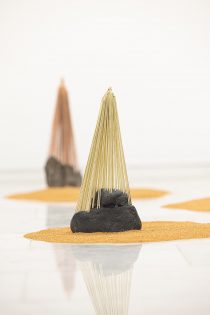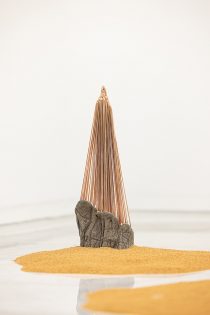About PARK Cheonwook’s works: the possibility of a unified subject _ Sangwoo Kim, 2015
|
About PARK Cheonwook’s works: the possibility of a unified subject Although the subject of art is not clear, perhaps the origin of art is artists. (PARK Cheonwook) 1.What could be the “subject” of art? Many would presume that art is part of a historic lineage of artworks and artists create its elements. It seems obvious in a sense, but it is not the reality of contemporary art. PARK Cheonwook destroys this question and explains that the origin of art is artists because production is the minimum necessary condition of art. Yes, “necessary condition” sounds like it cannot be a sufficient condition. For the in-house program of the Nanji Residency, he produced <The Shape of Ginger> (2015) to clearly show his criticism (in a coincidental form) regarding the issue. Exhibition curated by artists are not rare these days, but his intention was quite interesting. He announced that it was an “exhibition for artists” and pointed out five issues: the entrance examination-centered fine arts education system as the origin of artistic practice; 2) personal records of failed artists that haven’t been publicized 3) a black box like system regarding the “recognition” of artists; 4) public and private institutions that distinguish recognition and doubt; and 5) an artist who functions as a unit in the system. Therefore, <The Shape of Ginger> revealed the hidden side of art (the origin), and, at the same time, tapped into the boundary of the structure of art. 2.The form of the exhibition is quite simple. In the exhibition space, he produced and placed drawings and sculptures that participating artists in the Nanji Residency would have learned at the ‘Hakwon,’[1]and filled the circular wall with examples of artists’ countless failed careers. The reason why he chose ginger is interesting. Not many people would have seen ginger in real life. Although we have heard about it, we do not know what it exactly looks like. When one tries to draw it, he or she would be uncertain of its shape. Park digs into this point and tracks the attitude of art institutions that demonstrate uncertain recognition standards and the artists’ positions. Artists go through more hurdles than any other professional groups –– from college entrance exams, contests, and residencies, artists are being evaluated every time. In fact, Park himself was recognized, and he had an exhibition as a resident of the Nanji Residency. But he stepped outside of his comfort zone, and asked honest questions. He realized the situation artists were dealing with, and presented his questioning as his awareness grew. It is not easy to recognize one’s position as an insider. Even though we wash our face and look into the mirror everyday, it is difficult to realize our naked self. It is a matter of introspection and reflection. Thus, <The Shape of Ginger> might be a type of internal criticism. This is the attitude of questioning the origin, which is a very rare thing in contemporary art. [1]Hakwon (학원), college preparation institutions that run crash courses for fine art 3.“Artists” would be the last “relics” of the modern subject, one who confronts the world alone, who seeks meaning although he knows he would fail. The “modern subject” had failed earlier, and was proved a long time ago that it is only a theoretical figure. It is clearly an anachronistic idea today. However, this does not dilute the value of this line of inquiry and it is always valuable to think about the possibility of this figure. It is necessary to survey and penetrate the whole system from the outside (if possible), rather than fulfilling the task as a cooperating member of the system. It will shake the internal order of the system. Measuring its impact is the second issue. Truth is usually forgotten as it is too common (Kojin KARATANI) and truthful information is easily concealed because they cause uncertainty (Norbert BOLZ). To reveal what has become invisible because it is either too familiar or natural is the way to find the origin. Perhaps (there is a slight chance that) this practice in the negative form might reveal the artist’s potential as a subject. 4.The artist has the right to ask questions about the origin. There are not many people who try to look at the backside of the mirror with curiosity. Mired in doubt, many people cannot remember their own reflections. Moreover, many of today’s systems consistently block people who ask such questions, including artists. The system wants artists to work as a unit in the system and train them to behave in that way. They silence those people. In the art world, guardians of the system like portfolio reviews, artist presentations, and projects cut and flatten the individual voices of a wide spectrum. 5.There are still other issues to consider. PARK Cheonwook asked a question through the act of “curating.” He approached the issue through a concept, not a visual form. Of course, there are similar traces in his works as well. For example, we can think about his Without belief series that transform the functions and structures of manufactured goods to defamiliarize familiar senses, or to show the goods’ destroyed functions. While not giving up on the formal aspects of traditional sculpture, he nullifies the function of forms by altering their given functions. He completely sacrifices the function for form. The video work, Without you, evokes a lot of insights as well. Painting his own body white in a white cube, and completely vanishing at last, the artist suggests the sense of removal –– no presence –– and, implies a type of “negative production.” In this way, his work usually reveals the hidden dimension and surveys the origin (structure) of art. In this sense, <The Shape of Ginger> is also the expanded result that reflects his mode of practice. The purpose, content, and form of the exhibition overturn existing conventions. 6.But it is difficult to decide whether or not he systemically and completely exposed the problem in the exhibition <The Shape of Ginger>. In his work, it is more like the clues are scattered here and there. Of course, this is not the personal problem of the artist. This can be interpreted as a reflection of the situation, which can only be confronted through concept. The complex reality of contemporary art cannot be captured in a visual form –– the traditional language of art. Unfortunately, the problem is that there is a chance this might be a nightmare. It is like catching one’s tail. This is because it also might be another routine in the closed circuit system as he used the Entrance examination-centered fine art education system as the metaphor for the origin of <The Shape of Ginger>and a project of subjectivity proved to be an illusion historically. It is like a maze in the sense that every time one opens a door another door pops up. Sangwoo Kim (Art Critic) |









